If you’ve ever been to France, you know that the French have a definite sweet tooth. Pastry shops can be found every other block in Paris it seems, with their colorful and picture-perfect sugary confections lined up in neat rows just waiting to be carried home for dessert. Interestingly, the word ‘dessert’ comes from the French verb desservir, meaning literally to ‘dis-serve’ or ‘to remove what has been served.’ At noble dining tables from the Middle Ages on, the table would be cleared at the end of the meal and light sweetmeats and liqueurs would be offered. By the middle of the 18th century, the French dessert course had reached its peak and had become essentially an art form in itself.
This glorious period in French sweets has a fascinating history, and this week’s post features art historian Alli Eagan who researched sugar art in France during the 18th century. Alli received her B.A. in Art History from the University of Virginia and her M.A. in Art History from the University of North Carolina at Chapel Hill. While in graduate school, she studied the art of French sugar sculptures from the illustrations and text of an 18th century French confectionery dictionary. Here are some excerpts from our recent conversation on this ephemeral aspect of French decorative and dessert arts:
How did you come to study 18th century French sugar art?
I took a wonderful graduate seminar on 18th century visual culture in France and England with a focus on empire, islands, gender and ‘sensibilité’ led by Dr. Mary Sheriff at UNC. I was struck by this fascinating dialogue between travel literature, islands, and the vast French and British empires. In particular, sugar (grown on island plantations throughout the empire) became a spoil of empire—an example of conquest and conspicuous consumption. And what better way to display your conquest than to bring it back home and make sugar art? And then too, mounds of sugar meant to look like sand from the islands sometimes adorned courtly tables as decoration in itself—a true mark of wealth and prestige.
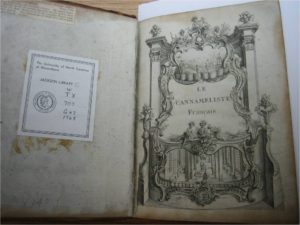
Le Cannaméliste, 1751 (All photos: A. Klos, courtesy of UNC, Greensboro, Special Collections)
Most importantly, I came upon the historical work entitled Le Cannaméliste français: ou, Nouvelle instruction pour ceux qui desirent d’apprendre l’office, rédigé en forme de dictionnaire (The French ‘Sugarcanist’ or New Instructions for Those Who Want to Learn the Office, Written in Dictionary Format), a confectionery dictionary by Joseph Gilliers published in Nancy, France in 1751. Intrigued by this idea of sugar art and even its popularity today (ie, cable television cake competitions and all the new pastry cookbooks that come out each year), I set out to understand how it manifested in the 18th century—from sugarcane plantations on islands throughout the empire to tabletop sugar sculptures in France. I ended up writing my MA thesis on this topic as I wanted to shed more light on the place of sugar art in art history.
What were some of the challenges of studying sugar and confectionery art?
For decorative art historians, sugar sculptures pose a unique problem—they are ephemeral, and historians must speak for objects that no longer exist as well as for feasts and performances that are bygone moments in time. Sugar, when used to mold and craft a sculpture or visual decoration, creates the most temporary of art forms; its impermanence as a medium is similar to that of ice. Both fragile and susceptible to changes in humidity, the delicate sugar sculptures and elegant fruit pyramids that graced courtly life in eighteenth-century France were meant to be enjoyed only in that moment. The art of the 18th century French confectioner survives today in Gilliers’s illustrated plates. They are embedded within the densely written text that alphabetically lists topics on the subject ranging from kitchen definitions, utensils, ingredients, syrups, and fruits to table displays. Other sources of this art might come from travel journals and personal accounts of the time.
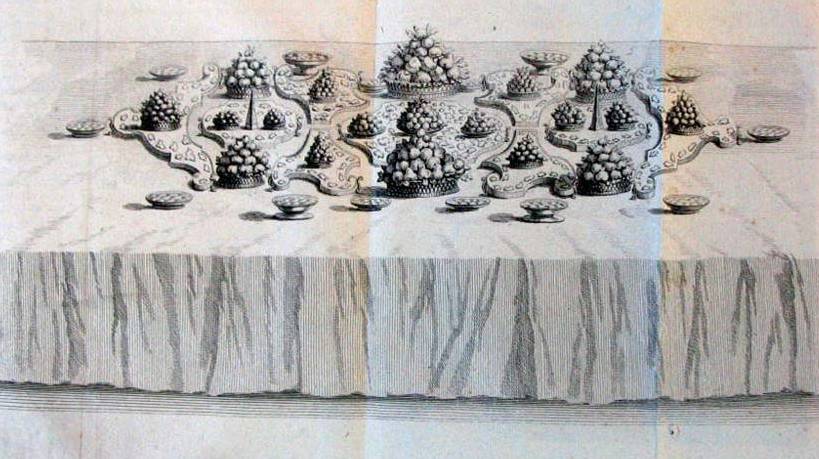
What are some of the sugar art designs that would have been seen on courtly tables?
When Gilliers’s text was written, the dining table was set in the service ‘à la française,’ which required that all the food and dishes be set before the diners sat at the table. The elaborate table display would have included desserts that remained on the table throughout the dinner or had been set up on a table in a nearby room. The desserts and delicate sugar sculptures were therefore part of a visual curiosity and work of art on the dining table. Designs included candied fruits, elaborate sugar temples and mythical figures from sugar paste, various sweetmeats, and more. You can see in Gilliers’ drawing that there would have been a painstaking effort to pre-plan both the design and execution of the table. This drawing shows an example of how even the table itself would have been designed to entice the viewer and provide a theatrical experience. You have to just imagine these illustrations in three dimensions and in living color – they must have been amazing!
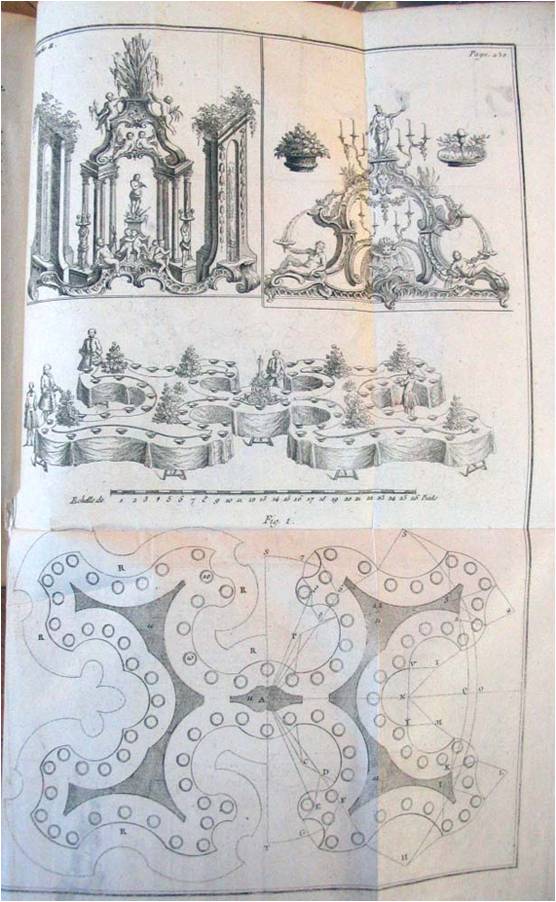
How does this art form relate to the French decorative arts?
While the sugar sculptures were impermanent, they were still complex and rich in rococo designs commensurate with other decorative arts of the period such as orfèvrerie (silver) and porcelain. For example, the sugar arabesque forms seen in Gilliers’ illustration below are completely rococo in style. They are resting on a ‘surtout de table’ (a decorative piece with mirrors designed for the center of a table). The curves are also reminiscent of the embroidery topiaries in French gardens of the time – all made out of sugar. In fact, many of the rococo arts became intertwined with sugar art so that sweet confections were displayed on dining tables with these mirrors, gold and silver pieces, porcelain objects and more. Today, it is interesting to see sugar sculptures and their designs live on in bisque porcelain pieces seen in museums around the world.
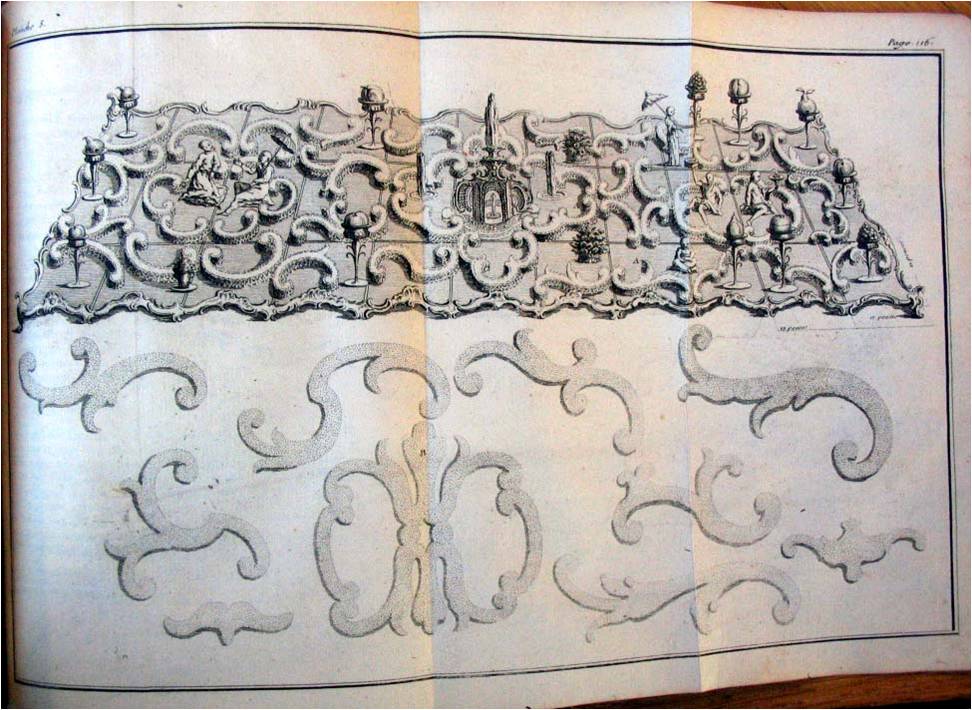
What is the historical significance to 18th century France?
While the confectionery dictionary may appear as a mere how-to manual of sugar creations, the illustrations represent the complex designs and historically important environments relevant to 18th court dining. In addition, the confectioner (confiseur) validates the highly regarded trade of the culinary arts at the time. You can see the confectioner here working diligently to execute the designs. The delicate flowers were all made by hand out of sugar paste. If you want to see some of this sugar art brought to life, I suggest watching the French movie Vatel (2000) with Gerard Depardieu. Vatel was a famous chef to the 17th century nobility who uses his confectionery and theatrical talents to stage many spectacular feasts and culinary celebrations.
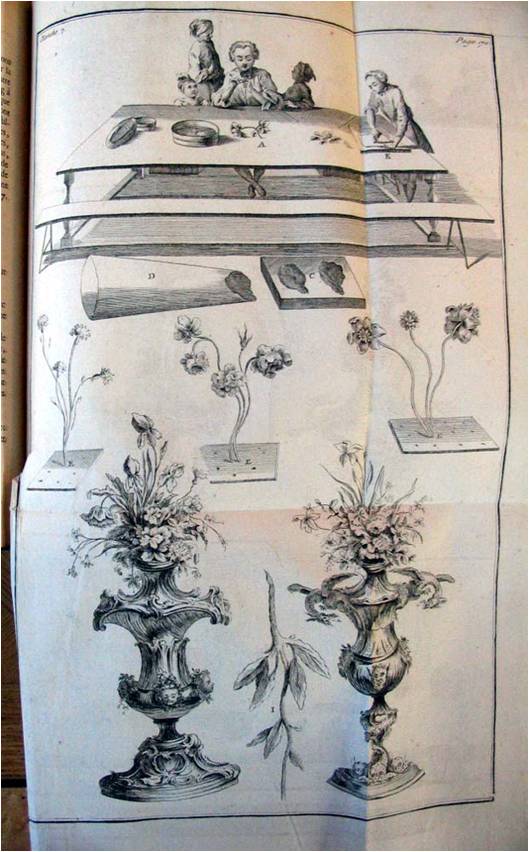
What did you learn about French sugar art that you do today in your own kitchen?
I learned about the virtue of display and creating a ‘tablescape’ type setting on your dining table. While the methods employed in the 18th century entailed rather large tables, extravagant displays, and a multitude of theatrics, you can take this theme of ‘enticement’ and display to your own home and kitchen. This idea also applies to the display of the dessert or pastry itself. When making my own French desserts such as Paris Brest, madeleines or macarons, I take the care to make sure it has that true ‘french polish’ of attention to detail and display. It makes these wonderful sweets taste even better!
A big thanks to Alli for sharing this wonderful of journey of French sugar art with us – as the French would say, “Merci infiniment!”
French Take-Out ~ La France à emporter
For a taste of world-class French sugar art currently happening in the U.S., be sure to check out the events and courses offered by The French Pastry School located in downtown Chicago. Founded in 1995 by Chefs Jacquy Pfeiffer and Sébastien Canonne, Meilleur Ouvrier de France, The French Pastry School provides superior instruction in the pastry, baking and confectionery arts.

Course offerings include options for food enthusiasts as well as professionals. Their amazing “Tasting Series” program offers French sweets fans the chance to see superb chefs demo fabulous recipes and engage in tastings accompanied by champagne and dessert wines. Culinary professionals can take advanced classes including the upcoming “Chocolate Showpieces for Competition or Display” in January or “Sugar Showpieces” in February. Be sure to click on these two courses just to see photos of incredible sugar art that is alive and well today!
And for those not living in or visiting Chicago anytime soon, the school’s co-founder Jacquy Pfeiffer has a new book coming out this December called The Art of French Pastry. This gorgeous volume brings the French Pastry School’s classes and recipes straight to you!
The French Pastry School – www.frenchpastryschool.com
226 West Jackson Boulevard
Chicago, IL 60606 USA